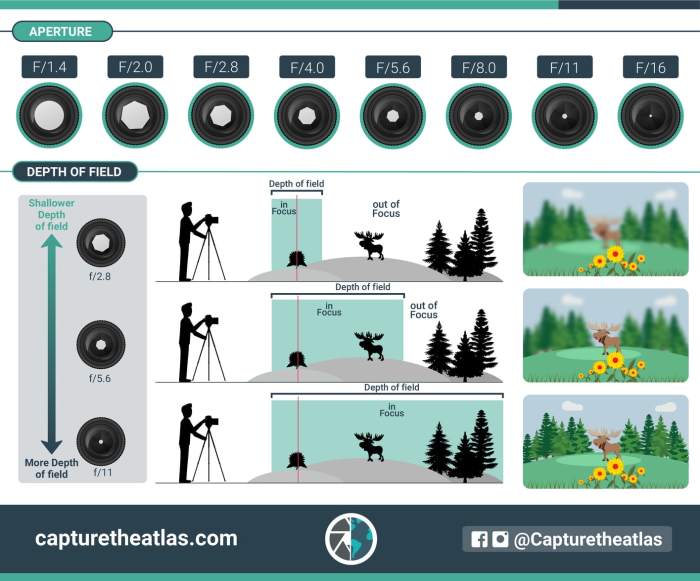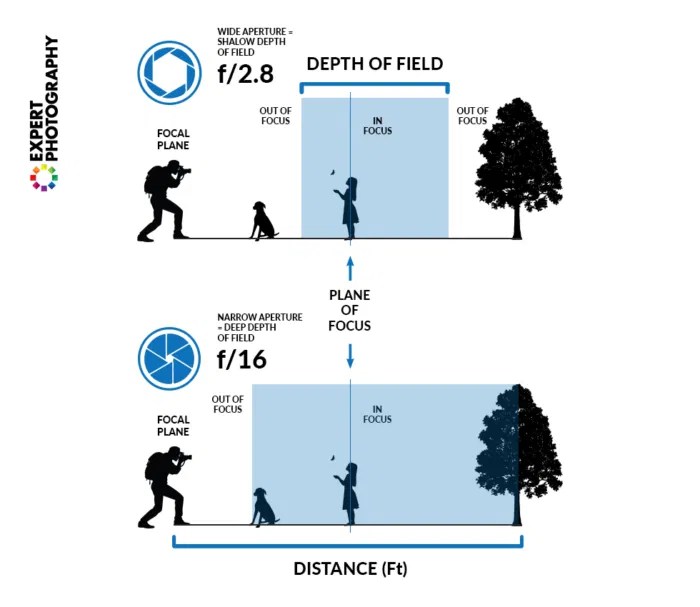
Embark on a journey to grasp the essence of aperture and depth of field in photography, exploring their intricate roles and impact on capturing stunning images. Dive into the world of photography with this enlightening guide that unveils the secrets behind creating visually captivating masterpieces.
Discover the power of manipulating aperture settings to craft mesmerizing shots that tell compelling stories through the interplay of light and focus.
Understanding Aperture and Depth of Field in Photography
Aperture plays a crucial role in photography as it controls the amount of light entering the camera lens. It is represented by the f-stop value, with lower f-stop numbers indicating larger apertures and higher f-stop numbers indicating smaller apertures.
Adjusting the aperture settings directly affects the depth of field in a photograph. A shallow depth of field results in a blurred background, emphasizing the subject in focus, while a deep depth of field keeps more elements in the scene sharp and clear.
Impact of Different Aperture Settings
- Wide Aperture (Low f-stop): Using a wide aperture like f/1.8 creates a shallow depth of field, ideal for portrait photography where the subject stands out against a soft, blurry background.
- Narrow Aperture (High f-stop): On the other hand, a narrow aperture such as f/16 increases the depth of field, suitable for landscape photography where you want everything from the foreground to the background to be sharp and in focus.
- Mid-range Aperture (Moderate f-stop): Apertures between f/5.6 to f/8 strike a balance between depth of field and light intake, making them versatile for various types of photography.
Importance of Aperture in Photography

Aperture plays a crucial role in photography, offering photographers creative control over the depth of field in their images.
Effects of Wide and Narrow Apertures on Depth of Field
- Wide Aperture (Low f-stop): When using a wide aperture like f/1.8 or f/2.8, the depth of field is shallow, resulting in a blurred background while keeping the subject in focus. This is ideal for portraits or macro photography where you want to isolate the subject.
- Narrow Aperture (High f-stop): On the other hand, a narrow aperture such as f/11 or f/16 creates a deep depth of field, ensuring that both the foreground and background are sharp and in focus. Landscape photography often benefits from a narrow aperture setting.
Choosing the Right Aperture Setting
When deciding on the aperture setting for your photography, consider the following tips:
- Portrait Photography: Opt for a wide aperture to create a beautiful background blur that emphasizes the subject.
- Landscape Photography: Choose a narrow aperture to ensure that both the foreground and background details are sharp and well-defined.
- Macro Photography: Experiment with wide apertures to isolate the subject and create stunning close-up shots with a dreamy background.
- Low-Light Photography: In low-light conditions, a wide aperture allows more light to enter the lens, enabling you to capture clear images without increasing the ISO too much.
Depth of Field and Its Significance
Depth of field refers to the range of distance in a photograph where objects appear acceptably sharp. It plays a crucial role in creating visually appealing images by allowing photographers to control what is in focus and what is blurred in a photo.
Importance of Depth of Field in Photography
- Depth of field can enhance storytelling in photography by directing the viewer’s attention to the main subject while blurring distracting background elements.
- It helps photographers convey a sense of depth and dimensionality in their images, making them more engaging and immersive.
- By manipulating depth of field, photographers can evoke different emotions and moods in their photos, adding layers of meaning to their visual narratives.
Techniques for Achieving Shallow or Deep Depth of Field
- To achieve a shallow depth of field (where the subject is sharp and the background is blurred), use a wide aperture (e.g., f/1.8 or f/2.8) and get closer to your subject.
- For a deep depth of field (where both the subject and background are in focus), use a narrow aperture (e.g., f/11 or f/16) and focus on a point one-third into the scene.
- Consider the focal length of your lens, as longer focal lengths tend to produce a shallower depth of field, while wider focal lengths result in a deeper depth of field.
Practical Applications of Aperture and Depth of Field

In photography, understanding how to use aperture and depth of field effectively can greatly enhance the quality and creativity of your images. Let’s explore some practical applications of these concepts in different genres of photography.
Portrait Photography
- When shooting portraits, using a wide aperture (low f-stop number) helps to create a shallow depth of field. This technique allows you to isolate your subject from the background, making them stand out more prominently in the image.
- By adjusting the aperture, you can control how much of the background is in focus, leading to beautiful bokeh effects that can add a dreamy and artistic touch to your portraits.
- For group portraits, a smaller aperture (higher f-stop number) may be more suitable to ensure that all subjects are in focus, especially when they are at varying distances from the camera.
Impact of Aperture on Landscape Photography
- In landscape photography, a smaller aperture (higher f-stop number) is often preferred to achieve a deep depth of field. This means that both the foreground and background elements in the scene will be sharp and in focus.
- Using a smaller aperture allows you to capture intricate details in the scenery, such as distant mountains, trees, or buildings, creating a sense of depth and scale in your landscape images.
- However, creatively using a wide aperture in landscape photography can also produce interesting effects by selectively focusing on a specific element in the scene while blurring the rest.
Using Aperture Creatively in Different Genres of Photography
- In macro photography, a wide aperture can help to isolate tiny subjects and highlight intricate details, while a smaller aperture ensures more of the subject is in focus.
- In street photography, adjusting the aperture allows you to control the amount of background distraction, emphasizing the main subject in the frame.
- For food photography, using a wide aperture can create a soft and appealing background blur, drawing attention to the delicious details of the dish being captured.
As we conclude our exploration into aperture and depth of field, remember that mastering these elements unlocks endless creative possibilities in photography, allowing you to unleash your artistic vision with every click of the shutter. Dive deeper into the world of photography and watch as your skills flourish and your images come to life in ways you never imagined.
Expert Answers
How does aperture affect the depth of field?
Aperture impacts the depth of field by controlling how much of the image is in focus. A wider aperture creates a shallower depth of field, while a narrower aperture increases the depth of field.
What is the significance of depth of field in photography?
Depth of field plays a crucial role in photography by adding dimension and emphasis to specific elements in an image, enhancing visual storytelling and creating impactful compositions.
Can aperture settings be adjusted on all types of cameras?
Most cameras, including DSLRs and mirrorless cameras, allow users to adjust aperture settings to control the amount of light entering the lens and the depth of field in the resulting image.





